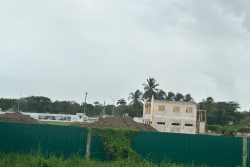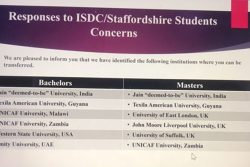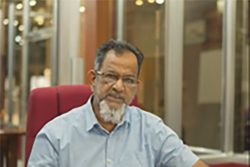Dear Editor,
Since September 2013 the world market price for sugar was fluctuating between US19 cents a pound and US16.50 cents a pound. The day before yesterday at the end of the day the NASDAQ commodities futures prices for raw sugar were US17.19 cents a pound. This tells us the long-term outlook for sugar, as far as price is concerned, is not good.
When GuySuCo met with the Economic Services Committee (ESC) of Parliament recently they informed the ESC that their current cost of production was US34 cents a pound and that by 2017 the price will come down to US24 cents a pound. This 24 cents a pound is still substantially more than the US17.19 cents per pound which is today’s price on the future of sugar. So bailing GuySuCo out of debt can become a perennial norm, rather than a few trounces of cash to help them to mechanise, with subsidies from the Consolidated Fund to become self-sufficient in time.
This conflicts drastically with CEO Singh’s declaration in the KN of July 12 that he was “clear about the need to continuously plug monies into strategic areas, with evidence suggesting that the industry could turn a profit when this is done.” This from a man whose experience in our sugar industry is not inspiring. The evidence he himself presents about his cost per pound tells us that it will never turn a profit. At his current cost per pound the selling price of sugar in the world market would have to be $761 dollars a tonne for raw sugar for him to turn a profit, the current world price is US$446/tonne. (Brazil’s production cost is around US$210 ton,) This low price is expected to prevail long after 2017 and Barrons, a renowned investment news entity tells us in July 2014, “The swelling output in Brazil, along with fresh supplies from Thailand, where the harvest began in late November, has investors betting that the slide in sugar’s price will continue, as demand remains thin. “‘It’s just too much supply,’ says Oscar Schaps, head of soft commodities.” Guyana plugging this amount of money into something which is just “in too much supply” when their cost of production is so high, is foolishness.
Not once, at any time did the CEO indicate that the production of ethanol from sugar cane was being seriously investigated by GuySuCo. Brazil has announced that their ethanol production can be economical when the price per barrel of crude oil is US$40 or over; the one year futures price for crude yesterday on NASDAQ was US$116/barrel. Even now when the farmers at Skeldon are protesting about the high amount of their canes required to produce a ton of sugar, if the factory at Skeldon was converted to ethanol production not one job would be lost. However, since the conversion of one ton of cane always produces 18 gallons of ethanol and since the cane can sit in a punt for a full week and still provide 18 gallons of ethanol from one ton of cane, whilst for sugar production it is essential that the cane be ground within 24 hours of delivery to the factory or inversion begins and less and less sugar can be made from it the longer it waits, having the factory grinding at 250 tons per hour instead of 350 tons an hour would make no difference to the production of ethanol and the price per ton of cane to farmers would not be affected. And since it takes much less power to produce ethanol than to produce sugar, co-generation can then become a true reality and not the fiction being peddled by GuySuCo.
Mistake after mistake has been the hallmark of GuySuCo’s decision-making over the past 10 years; they are plugging the production of special sugars, first at the Blairmount factory which I believe cost us US$9 million to produce packaged ‘Demerara Gold’ which has never been an economic success, and now the US$12 million packaging plant at Enmore which did not work for most of last year since there was not enough cane to meet their market commitments for bulk sugar.
Having committed to this US$200 million expansion of the Guyana industry at Skeldon, a monstrous mistake by itself, they are reluctant to admit that they created a white elephant and are now making a second mistake by turning to the production of special sugars instead of ethanol, which is what they should have done once they had made this disastrous decision to expand the Guyana industry when everyone else was downgrading/abandoning theirs. Trinidad, Jamaica, St Kitts and Barbados are good examples due to the loss of the EU subsidy.
This most unfavourable picture is made even more grim since GuySuCo is conducting the very expensive conversion from traditional fields to a mechanical harvester friendly field layout at the same time, a layout which many knowledgeable people in the industry, including me, believe is fraught with much danger especially since the estimated cost of doing it is US$1,500 per hectare. We are not being told what effect this has had, and will continue to have on the yield of the cane per hectare, that is very low at this time. I have to keep referring to the complaints of Mr Bhim and Mr Komal Chand that there is “no cane in the fields”!
In addition, information we have from other sources in Guyana, indicate that the mechanisation process is causing horrendous damage to the fields, destruction of the cane rows in the areas where the harvesters turn around on each run and heavy compaction of the soil which destroys its tilth and productivity. None of this has been acknowledged much less quantified by this GuySuCo delegation to the ESC. In addition they are planning to convert 8000 hectares @US$1500 us per hectare by 2017; this means that they will have to dip into the Consolidated Fund for $2.4 billion to do that alone. This is in addition to the $6 billion they are estimating that they will need to buy harvesters, trailers and loaders to mechanise; and when we factor in the already high accumulated losses, the inefficient cost of production which is currently nearly 100% higher than the world market price for sugar, a very disturbing picture riddled with red ink emerges.
I consider that GuySuCo did not present to the ESC a proper picture of the huge hurdles mechanisation presents to the industry. They did not indicate what their accumulated losses were at this time and the total amount that the corporation owes, since they have clearly run out of money and credit to pay their staff, which they failed to do last week.
Incredibly the ESC did not ask them why they have not presented an annual report to Parliament since 2009, which they are required to do, by law, annually.
The accuracy of most of his presentation to the ESC is also a cause for concern; for example Singh told the ESC that under Guyana’s soft, muddy, badly drained fields with heavy rainfall, the GuySuCo machines harvest 35-40 tonnes per hour. This totally conflicts with a substantial body of work done in other countries which tells me that under the best field conditions 20 tons an hour is a more realistic estimate.
In addition they are claiming that after they mechanise their costs will come down to 25% of what it was using hand labour. This conflicts also with information from other countries. Brazil, for example, where they are now being forced to stop burning cane by 2020 due to pollution and are phasing out all manual labour by then, is claiming that the reduction in cost from manual to machine is only 50%.
Harvesting by machine requires the breeding of newer varieties of cane which are selected through decades of field trials for being very erect in habit to present the cane more efficiently to the harvester; we have bred no such varieties. In fact our canes especially when the yield is high grow exactly the opposite to erect. Secondly, mechanical harvesting leaves a higher stump in the fields, especially those like ours which are not precision levelled by laser. This causes sugar losses by leaving the sweetest part of the cane close to the base in the ground and also hampers regrowth.
No mention was made of the fact that mechanical harvesting results in a lot of mud getting into the factory with the cane, and at the Skeldon factory which uses diffusers to extract the sugar instead of mills, this has resulted in stoppages of the factory every shift to clean it.
In view of these discrepancies in the presentation by GuySuCo to parliament, there should be a full investigation by some sort of commission into the workings of this industry, since it is clear to me that the picture presented to the highest forum in the land, the Guyana Parliament, was seriously, deliberately or through inexperience, distorted and was, as is now usual for GuySuCo, long on optimism and short on realism. Especially since the business of this corporation, which is asking the taxpayers of this country to subsidise it, is run in total secrecy; even senior managers are terrified of giving out any information whatsoever on its functioning.
Yours faithfully,
Tony Vieira








